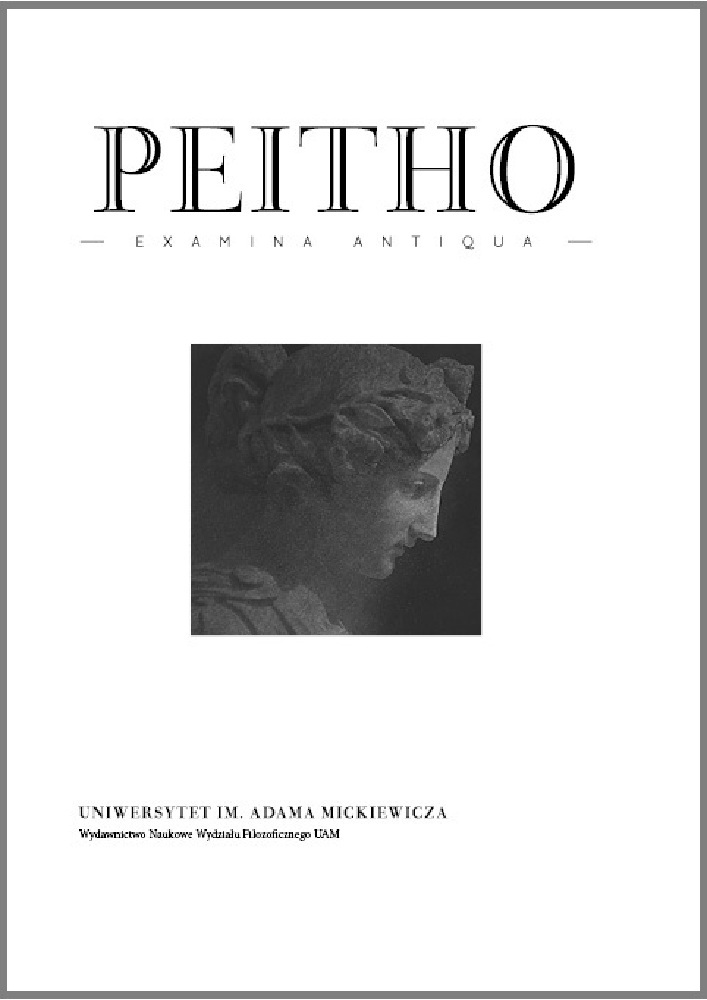Abstract
In this study, I show how Plato in the Parmenides reprises the encounter with the Phaedo’s Antisthenes, whom I elsewhere assumed to be one of the various tis that get examined in the dialogue. Now, with the Parmenides’ tis, a similar situation arises: this Antisthenes embodies such characteristics as being “an expert in many areas”, “not without natural gifts” and “capable of following with critical intelligence” the logoi taken from “distant premises.” In the four logoi of the gumnasia, I highlight how Plato, in developing his exercise, proceeds on his own way without openly arguing with any tis and how, despite his detached attitude, his hodos, while interweaving with that of his colleague Antisthenes, enters into a conflict. I then demonstrate how the two paths, despite having a common aporetic beginning (the objections of Gorgias to Parmenides and the testimony of Proclus against Antisthenes), at times overlap and at times are mutually exclusive. From this, I also argue that whoever wrote the dialogue must have been aware that the path, although apparently linear and rectilinear, was in fact bumpy and tortuous.
References
Allen, R.E. (ed.), 1983, Plato’s Parmenides (ed.), Minneapolis.
Berti, E., 1970–71, “Struttura e significato del «Parmenide» di Platone”, Giornale di Metafisica 26, pp. 497–527.
Brancacci, A., 1990, Oikeios logos. La filosofia del linguaggio di Antistene, Napoli.
Brancacci, A., 2010, “Aristotele e la dottrina del sogno nel Teeteto”, in: Mazzara, Napoli (2010), pp. 43–59.
Burnet, J. (ed.), 1901, Platonis Opera, t. II, Oxford.
Casertano, G., 2015a (trad.), Platone, Fedone o dell’anima. Dramma etico in tre atti, Napoli.
Casertano, G., 2015b, “Da Parmenide di Elea al Parmenide di Platone”, in: Casertano et al. (2015), pp. 43–125.
Casertano, G. et al., 2015, Eleatica 2011: Da Parmenide di Elea al Parmenide di Platone, F. Gambetti, S. Giom¬bini (cur.), Sankt Augustin.
Cornford, F.M.D. (ed.), 1939, Plato’s and Parmenides, London.
Ferrari, F., 2015, “L’essere (e il non essere) nel Parmenide di Platone”, in: Casertano et al. (2015), pp. 148–152.
Ferrari, F., (trad.), 20198, Platone Parmenide, Milano.
Fronterotta, F., 20084, Platone, Parmenide, Roma–Bari.
Fronterotta, F., 2015, “Sulla natura del genere del diverso nel Sofista”, in: Casertano et al., (2015), pp. 153–158.
Mazzara, G., 2005, “La rhétorique éléatico-gorgienne d’Alcidamas chez Diogène Laërce (IX 54) et les quatre fonctions fondamentales du
logos”, L’Antiquité Classique 74, pp. 51–67. https://doi.org/10.3406/antiq.2005.2563 DOI: https://doi.org/10.3406/antiq.2005.2563
Mazzara, G., 2010, “L’Aiace e l’Odisseo di Antistene come ipotesi di lettura della teoria del sogno e dei tre sensi di logos dati da Platone per interpretarla”, in: Mazzara, Napoli (2010), pp. 225–262.
Mazzara, G., 2014, “La logica di Antistene nell’Aiace e nell’Odisseo”, in: Suvák (2014), pp. 121–167.
Mazzara, G., 2018, «Platone di fronte a Parmenide, Gorgia ed Antistene nel Sofista», in: M. Pulpito, P. Spangenberg (eds.), hodoi noēsai – Ways to think. Essays in Honour of Néstor-Luis Cordero, Bologna, pp. 294–295.
Mazzara, G., 2019, “Platone e Antistene nel Fedone: una lettura in controluce. Parte Prima”, Peitho. Examina antiqua 1 (10), pp. 13–44. https://doi.org/10.14746/pea.2019.1.1 DOI: https://doi.org/10.14746/pea.2019.1.1
Mazzara, G., 2020, “Platone e Antistene nel Fedone: una lettura in controluce. Parte Seconda”, Peitho. Examina antiqua 1 (11), pp. 33–66. https://doi.org/10.14746/pea.2020.1.2 DOI: https://doi.org/10.14746/pea.2020.1.2
Mazzara, G., Napoli, V. (cur.) 2010, Platone. La teoria del sogno nel Teeteto. Atti del Convegno Internazionale. Palermo 2008, Sankt Augustin.
Migliori, M., 20002, Dialettica e verità. Commentario filosofico al “Parmenide” di Platone, Milano.
Narcy, M., 2010, “Socrate et Théétète font-ils le même rêve?”, in: Mazzara, Napoli (2010), pp. 263–279.
Ranzato, S., 2015, “Il Koūros diventa maestro: note sull’incontro tra Socrate e Parmenide”, in: Casertano et al. (2015), pp. 192–198.
Rossetti, L., 2020, “Verso la filosofia. Nuove prospettive su Parmenide, Zenone e Melisso”, in: Rossetti et al. (2020) pp. 51–167. https://doi.org/10.5771/9783896659279
Rossetti, L., et al., 2020, Eleatica 8: Verso la filosofia: Nuove prospoettive su Parmenide, Zenone e Melisso, N.S. Galgano, S. Giombini, F. Marcacci (cur.), Sankt Augustin. https://doi.org/10.5771/9783896659279 DOI: https://doi.org/10.5771/9783896659279
Rostagni, A., 1922, “Un nuovo capitolo nella storia della retorica e della sofistica”, Studi italiani di filologia classica 2, pp. 148–201.
Suvák, V., (ed.) 2014, Antistenica Cynica Socratica, Praha.
License
Copyright (c) 2022 Giuseppe Mazzara

This work is licensed under a Creative Commons Attribution 4.0 International License.
Peitho provides immediate open access to its content on the principle that making research freely available to the public supports a greater global exchange of knowledge.
